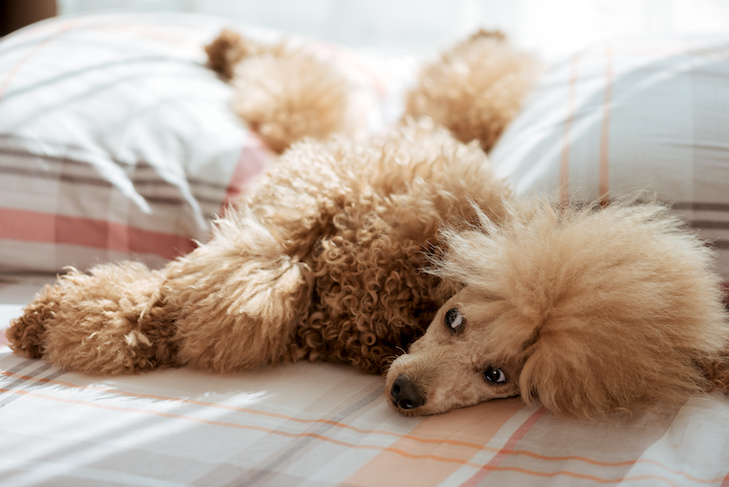Welcoming a dog into your home is a joyful experience filled with companionship, love, and countless adventures. However, the challenges of pet ownership can sometimes lead to unexpected situations—such as discovering that your furry friend has mistaken your bed for a bathroom. If you’re facing this frustrating issue, rest assured that you are not alone, and there are effective solutions to help you reclaim your space.
In this article, we will explore proven strategies to stop your dog from peeing or pooping on the bed, addressing the various reasons behind this behavior and sharing practical tips to guide you and your pup toward a happier and cleaner home environment. So, let’s dive in and find the right approach for you and your four-legged companion!
Table of Contents
- Understanding the Cause of Inappropriate Bathroom Habits in Dogs
- Creating a Consistent Potty Routine for Your Pet
- Effective Training Techniques to Redirect Bathroom Behavior
- Tips for Managing Your Dogs Access to the Bed and Home Environment
- Q&A
- To Wrap It Up
Understanding the Cause of Inappropriate Bathroom Habits in Dogs
Inappropriate bathroom habits in dogs can stem from various underlying causes, which need to be addressed for effective behavior modification. Medical issues are often at the forefront; conditions such as urinary tract infections, gastrointestinal disorders, or even age-related problems can lead to accidents inside the house. Behavioral factors also play a vital role, including stress caused by changes in the environment, anxiety from separation, or simply a lack of proper house-training. Understanding these underlying issues is crucial for preventing further incidents.
Another important aspect to consider is the training methods previously employed. Sometimes, a dog may not fully grasp where it is appropriate to relieve itself, especially if they have been inconsistently trained. To help pinpoint the cause, owners can keep track of their dog’s habits using a simple chart, which might include:
| Time of Day | Location | Type of Incident |
|---|---|---|
| Morning | Bed | Pee |
| Afternoon | Living Room | Poop |
| Evening | Outside | None |
This chart can assist owners in identifying patterns that may reveal specific triggers. Once the root causes are understood, appropriate steps can be taken to create a conducive environment where the dog feels secure and is encouraged to use the designated potty areas.
Creating a Consistent Potty Routine for Your Pet
Establishing a reliable potty routine for your pet is crucial in preventing unwanted accidents inside the house. Start by observing your dog’s natural habits and determine their typical bathroom schedule. Consistency is key, so aim to take your dog out to the same spot at the same times every day. At a minimum, consider incorporating the following elements into your routine:
- Morning: Take your dog out first thing after waking up.
- Post-Meal: Allow your dog outside after feeding them.
- Before Bed: Take your pet out last thing before you settle in for the night.
- After Playtime: Always give your dog an opportunity to relieve themselves after an active session.
In addition to setting specific times for potty breaks, keep a close eye on your dog’s behavior as they signal their need to go out. Look for signs such as sniffing, whining, or pacing, which can indicate they need to relieve themselves. When you notice these behaviors, respond promptly to reinforce the potty routine. You might find it helpful to track your dog’s potty habits using the table below:
| Time of Day | Activity | Notes |
|---|---|---|
| Morning | Potty Break | After waking up |
| After Meals | Potty Break | Observe behavior closely |
| Before Bed | Final Potty Break | Ensure restfulness overnight |
| Post Playtime | Potty Break | Encourage frequent trips outside |
Effective Training Techniques to Redirect Bathroom Behavior
Redirecting unwanted bathroom behavior in dogs requires patience and consistency. One effective technique is to establish a routine. Dogs thrive on predictability, so taking them out to their designated bathroom area at regular intervals can significantly reduce accidents. Consider the following tips to create a successful routine:
- Frequent potty breaks: Take your dog out first thing in the morning, after meals, and before bedtime.
- Positive reinforcement: Reward your dog with treats and praise immediately after they relieve themselves outside.
- Monitor water intake: Limit your dog’s water access before bedtime to minimize nighttime accidents.
In addition to establishing a routine, you can also utilize redirection techniques when you catch your dog in the act. Here’s how to effectively redirect their behavior:
- Interrupt and redirect: If you see your dog preparing to go on the bed, use a firm “no” to interrupt them and promptly lead them to the appropriate bathroom area.
- Create a designated potty spot: Choose a specific outdoor location for bathroom breaks to foster familiarity.
- Keep bedding clean: Wash any soiled bedding promptly to eliminate odors that might encourage repeat behavior.
Tips for Managing Your Dogs Access to the Bed and Home Environment
Establishing clear boundaries for your dog’s access to your bed and home environment is essential for maintaining a harmonious household. One effective method is to designate specific areas where your dog is allowed to relax, ensuring they feel secure and comfortable while keeping your sleeping space clean. Consider the following tips to help manage your dog’s access:
- Create a designated sleeping area: Use a comfortable dog bed located away from your bed to help your dog understand their space.
- Utilize baby gates: These can be effective in restricting access to certain rooms, including your bedroom, while still allowing your dog to feel part of the family.
- Implement a routine: Establish a consistent routine for bedtime, ensuring your dog knows when it’s time to go to their designated area.
- Positive reinforcement: Reward your dog with treats and praise when they use their own bed, reinforcing the behavior.
In addition to creating physical boundaries, it’s important to monitor your dog’s behavior and habits within the home environment. Regularly assess your dog’s potty needs and ensure they have ample opportunities to relieve themselves outside, especially before bedtime. Consider implementing the following strategies:
| Time of Day | Action |
|---|---|
| Morning | Take your dog for a walk immediately after waking up. |
| Afternoon | Schedule a potty break after meals. |
| Evening | Allow for a final potty break before settling down for the night. |
By combining boundary-setting and attentive potty management, you can create a positive home environment for both you and your dog that discourages unwanted accidents on your bed.
Q&A
Q: Why does my dog pee or poop on the bed?
A: There could be several reasons for this behavior. Dogs may urinate or defecate on the bed due to anxiety, marking territory, a medical issue, or insufficient house training. Understanding your dog’s motivations is the first step in addressing the problem.
Q: What should I do if my dog has an accident on my bed?
A: First, remain calm and avoid punishing your dog. Clean the area thoroughly with an enzyme-based cleaner to eliminate odors that might encourage repeat behavior. Then, observe your dog for any signs of distress or discomfort, and consult a veterinarian if you suspect a medical issue.
Q: How can I reinforce house training?
A: Consistency is key in house training. Establish a routine for bathroom breaks, reward your dog for going outside, and monitor their behavior closely. If they show signs of needing to go, take them out immediately. Use positive reinforcement to encourage good habits.
Q: What are some strategies to reduce anxiety in dogs?
A: Creating a comfortable environment can help alleviate anxiety. Provide a safe space, engage in regular exercise, and consider using calming products like pheromone diffusers or anxiety wraps. Training techniques and socialization can also boost their confidence.
Q: Should I restrict access to the bed?
A: Yes, temporarily restricting access to your bed may be a good idea, particularly if your dog is persistently having accidents there. Use baby gates or close doors to keep them away until the behavior is corrected. Gradually reintroducing them to the bed can also help, provided the problem has been resolved.
Q: Are there any medical issues that could cause this behavior?
A: Absolutely. Conditions such as urinary tract infections, gastrointestinal issues, or other health problems can lead to inappropriate elimination. If you notice sudden changes in your dog’s bathroom habits or if accidents continue despite proper training, consult your veterinarian for a check-up.
Q: How can I make my dog feel more comfortable using their designated bathroom area?
A: Make the designated bathroom area appealing by ensuring it’s clean and easily accessible. Use positive reinforcement when your dog goes in the right place, and consider creating a specific spot where they can consistently go. Praise and treats can encourage further success.
Q: What kind of professional help is available if I can’t resolve the issue myself?
A: If you’re struggling to manage your dog’s behavior, consider seeking help from a professional trainer or a veterinary behaviorist. They can offer tailored strategies and insights based on your dog’s specific needs and circumstances.
Q: How long will it take to train my dog not to pee or poop on the bed?
A: The timeline can vary depending on your dog’s age, temperament, and any underlying issues. With consistency, patience, and the right techniques, many owners see improvement within a few weeks. However, some cases may take longer, so staying committed is crucial.
Q: Can certain breeds be more prone to this behavior?
A: While any dog can develop inappropriate elimination issues, certain breeds may be more prone to anxiety or territorial marking. It’s essential to understand your dog’s breed characteristics and tailor your training approach accordingly.
Remember, every dog is an individual, and what works for one might not work for another. Stay patient and loving throughout the process, and you’ll be well on your way to solving this challenge. Happy training!
To Wrap It Up
addressing the issue of your dog peeing or pooping on the bed requires a blend of understanding, patience, and effective strategies. By identifying the underlying causes, whether they be health-related, behavioral, or environmental, you can take targeted steps to resolve the problem. Remember, consistency is key, and positive reinforcement can go a long way in encouraging your pup to choose appropriate potty spots.
If the situation persists or if you have concerns about your dog’s health, don’t hesitate to consult with a veterinarian or a professional dog trainer. Your furry friend deserves a comfortable and clean space to rest, and with the right approach, you can create a happy and harmonious home. Thank you for reading, and here’s to many peaceful nights ahead—free from unwanted surprises!
















